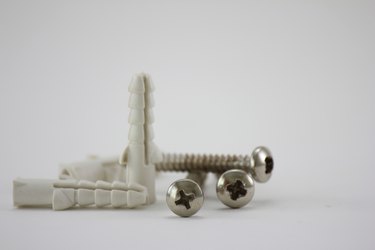
A house doesn't feel much like home until you've hung a few things on the walls, which is why drywall anchors are an unsung but important part of home decoration and design. You'll need them if you want to hang anything much heavier than a paper calendar or the smallest of photos because plain nails or screws simply can't provide a sturdy grip on drywall. There are suitable anchors for most purposes, supporting weights from just a few pounds to a hundred or more.
Tip
Drywall anchors are typically rated for 150 pounds or less, but special-purpose anchors can be rated for significantly greater weights. Always choose an anchor rated for a weight equal to or greater than the weight of the item it will support.
Video of the Day
Expansion Drywall Anchors
Expansion drywall anchors are the type with which most homeowners are familiar. They can be made of vinyl or metal, but both types work the same way. You start by drilling a pilot hole into the wall for your anchor and then tap it in gently with a hammer or ideally a rubber mallet. When you drive a screw into the anchor, its shank spreads, providing a sturdy grip on the drywall.
Video of the Day
Tap-in and self-screwing anchors work in exactly the same way, but they're designed to not require a pilot hole. They can either be installed with a hammer (tap-in) or screwed directly into the wall with a screwdriver (self-screwing). Once installed, they work exactly the same as other expansion anchors. In practice, you may find that these anchors will deform under the stress of installation, especially if you opt for the vinyl type, and you might still choose to drill a small pilot hole to minimize the risk.
These anchors are inexpensive and are suitable for light-duty applications, with standard versions usually topping out at about 25 pounds, and self-threading anchors going as high as 75 pounds. The anchor's size roughly parallels its weight-bearing capacity. Reflexively using a larger than needed anchor "just in case" isn't always a good idea in scenarios where the screws will be mounted close together, such as the handrail on a stairway. This may not leave enough drywall between the screws to ensure a lasting grip, which means you'll ultimately need to patch the wall and relocate the screws.
"Molly Bolt" Wall Anchors
Molly bolts are a specialized form of expanding wall anchor. They consist of a metal sleeve — the actual anchor — and a matching screw. Installing them requires drilling a pilot hole and then inserting the sleeve into the hole. When you tighten the screw, you compress the sleeve and force it to expand, locking it securely into the drywall.
"Mollies" are a medium-weight anchor, typically at ratings from 25 pounds to 50 or more. What makes them unique is that unlike most anchors, you can remove and replace the screw once they're installed. This makes them a versatile option for items such as towel bars and small wall-mounted cabinets or shelves, which might be swapped out periodically or updated for aesthetic reasons.
Wing and Toggle Wall Anchors
Structurally, drywall consists of compressed gypsum sandwiched between two layers of tough, sturdy paper. Wing- and toggle-type anchors work by piercing completely through the sheet of drywall and then opening a pair of "wings" or a toggle in the space behind the drywall. When you tighten the screw or bolt, it pulls the wings or toggle firmly to the back of the drywall. Because you can't pull the anchor out without physically tearing a hole directly through the drywall from back to front, this gives substantially greater holding power.
Plastic "wing" anchors tap into your pilot hole in the same way as a conventional expansion anchor. Once it's in place, you'll insert the supplied wand to expand the wings and then drive your screw into the anchor.
Toggle anchors come in several styles. With flip toggles, the toggle portion of the anchor lies parallel to the anchor's bolt during installation and then flips into position once it's through the wall. Wing-type toggles are threaded and hinged in the middle. To install them, you'll drill a large pilot hole, hold the wings in their closed position with your fingers, and then push the hinged portion of the anchor through the hole. When it emerges at the back of the drywall, the spring will pop it open, and you can then tighten the bolt to complete your installation.
Plastic wing anchors are typically suitable for up to 20 pounds, while most metal toggles top out at 100 to 150 pounds. Specialized heavy-duty anchors can exceed that rating, safely holding 300 pounds or more.
Weight Ratings and Real Life
The weight rating for a wall anchor is printed on its packaging, or in the case of online orders, it's a key feature mentioned in the sales copy. Those ratings are generally conservative, and when anchors are put to the test, most of them exceed their rating by a comfortable margin. The catch is that these ratings assume a fixed load. If you're wall-mounting a kids' desk/play table or anything else that could have unpredictable pressures applied to it, you might need a heavier-duty anchor than the weight alone would suggest.